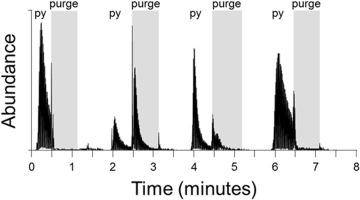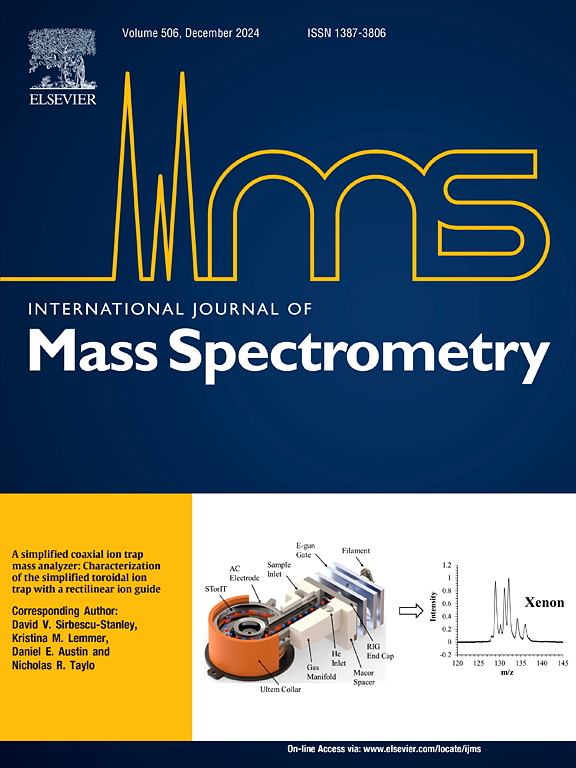Pyrolysis and thermal extraction of polymeric materials with suction-driven, real-time ionization sources and rapid polarity switching, high resolution mass spectrometry
IF 1.7
3区 化学
Q3 PHYSICS, ATOMIC, MOLECULAR & CHEMICAL
引用次数: 0
Abstract
Real-time sampling systems are assembled for analysis of pyrolyzed material using in-line ionization and high resolution mass spectrometry. Two commercial models of Pyroprobe pyrolyzer with either a wand-mounted coil or a drop-in sample chamber are reconfigured from the standard gas chromatograph interface. Either a flow cell containing a platinum coil or a drop-in pyrolysis chamber is connected to a heated transfer line that conducts pyrolysates directly to a photoionization or dielectric barrier discharge source. The ion source is mounted to the front of an Orbitrap system, drawing analyte through from the pyrolyzer using instrument vacuum and/or supplementary pumping. The mass spectrometer scans in rapidly-alternating polarity so that positive and negative mode analyses are acquired in a single run. Pyrolyzed samples of tens of micrograms of polymeric materials yielded robust and resolved signal, especially from halogenated ions in negative mode that otherwise did not produce enough electron impact ionization signal for identification. The photoionization source in particular was easily purged of lingering pyrolysate by temporarily increasing the supplemental flow rate, rapidly returning signal to baseline levels after an analytical run. Elimination of carryover allowed replicate analyses to be collected at a rate of every 2 min without an autosampler. Slow-ramp thermal extraction analyses was performed on the same system as flash pyrolysis without any change in hardware.

吸附驱动,实时电离源和快速极性切换,高分辨率质谱的聚合物材料热解和热萃取
实时采样系统组装用于使用在线电离和高分辨率质谱分析热解材料。两种商业型号的Pyroprobe热解仪,无论是一个棒安装线圈或一个滴入式样品室,从标准气相色谱仪界面重新配置。含有铂线圈的液流池或插入式热解室连接到加热传输线,该传输线将热解物直接传导到光电离或介质阻挡放电源。离子源安装在Orbitrap系统的前部,使用仪器真空和/或辅助泵送从裂解器中抽出分析物。质谱仪以快速交替的极性扫描,以便在一次运行中获得正、负模式分析。几十微克聚合物材料的热解样品产生了强大的和可分辨的信号,特别是从负模式的卤化离子,否则不会产生足够的电子冲击电离信号来识别。通过暂时增加补充流速,光电离源很容易清除残留的热解产物,在分析运行后迅速将信号恢复到基线水平。消除携带允许重复分析在没有自动进样器的情况下以每2分钟的速率收集。在不改变硬件的情况下,在与闪速热解相同的系统上进行慢速热萃取分析。
本文章由计算机程序翻译,如有差异,请以英文原文为准。
求助全文
约1分钟内获得全文
求助全文
来源期刊
CiteScore
3.60
自引率
5.60%
发文量
145
审稿时长
71 days
期刊介绍:
The journal invites papers that advance the field of mass spectrometry by exploring fundamental aspects of ion processes using both the experimental and theoretical approaches, developing new instrumentation and experimental strategies for chemical analysis using mass spectrometry, developing new computational strategies for data interpretation and integration, reporting new applications of mass spectrometry and hyphenated techniques in biology, chemistry, geology, and physics.
Papers, in which standard mass spectrometry techniques are used for analysis will not be considered.
IJMS publishes full-length articles, short communications, reviews, and feature articles including young scientist features.

 求助内容:
求助内容: 应助结果提醒方式:
应助结果提醒方式:


